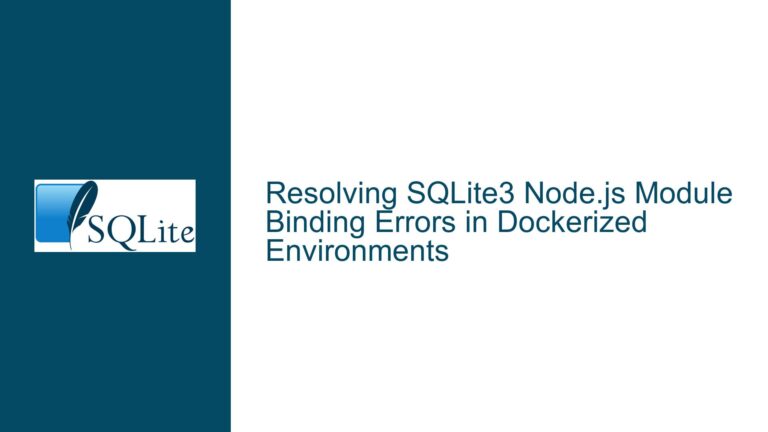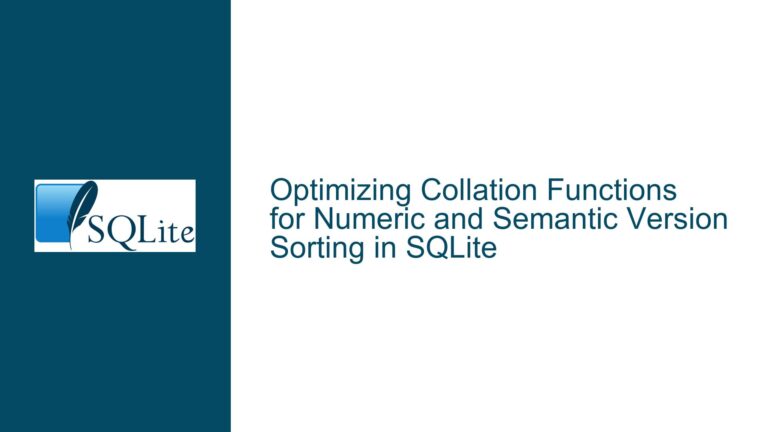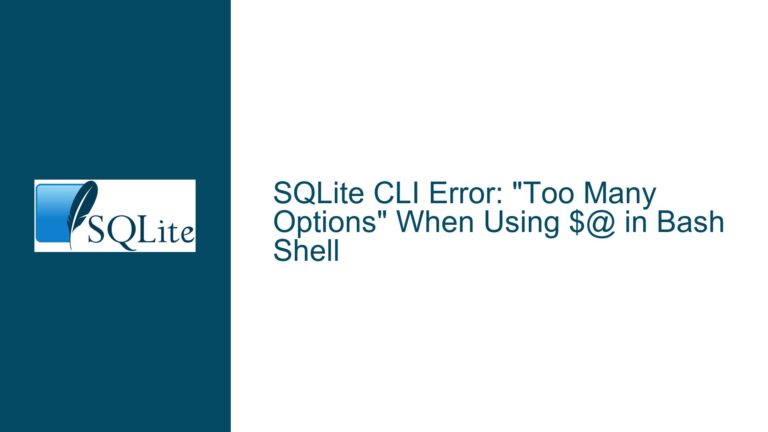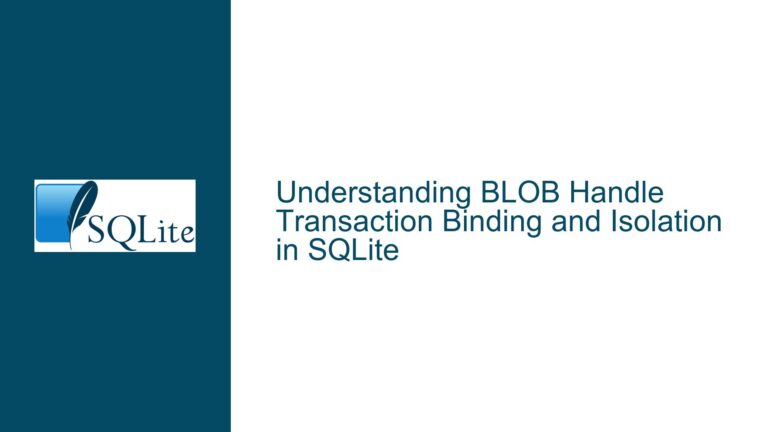Associating SQLite Update Hooks With Transactions and Resolving Rollback Callback Loops
Understanding Transaction Boundaries in SQLite Update Hooks and Trace Callbacks
The core challenge revolves around correlating SQLite’s data modification events (captured via sqlite3_update_hook and sqlite3_trace_v2 callbacks) with transaction context. Developers often need to determine whether database changes occur within explicit transactions (BEGIN…COMMIT/ROLLBACK blocks) or implicit auto-commit transactions, and which specific transaction a particular operation belongs to. A secondary issue involves infinite recursion in rollback hook callbacks when using JNI (Java Native Interface) implementations.
SQLite’s transaction model operates under strict ACID principles, where all database modifications must occur within transaction boundaries. The automatic creation of implicit transactions for standalone statements complicates transaction tracking. When using diagnostic interfaces like update hooks and trace callbacks, developers frequently encounter three key limitations: 1) No built-in transaction ID metadata in callback parameters 2) Connection-specific isolation of hook events 3) Asynchronous nature of hook invocations relative to transaction control statements.
The rollback hook looping problem demonstrates how transaction-related callbacks can inadvertently trigger reentrant behavior when combined with JNI environment management. This occurs due to SQLite’s internal transaction state machine reacting to unexpected API usage patterns within callback handlers, particularly when Java/Kotlin code interacts with native SQLite connections through the Android NDK.
Transaction Tracking Limitations and JNI Callback Reentrancy
Update Hook Transaction Context Deficiency
SQLite’s sqlite3_update_hook fires after data modification (INSERT/UPDATE/DELETE) but provides no direct information about the encompassing transaction. The callback receives operation type, database name, table name, and rowid – but no transaction identifier or explicit/implicit transaction flag. This forces developers to implement transaction state tracking through auxiliary means.
Implicit vs Explicit Transaction Ambiguity
Every SQL statement executes within a transaction – either an explicit transaction started with BEGIN or an automatic single-statement transaction. The update hook makes no distinction between these cases. Trace callbacks (via sqlite3_trace_v2) can capture BEGIN/COMMIT/ROLLBACK statements, but correlating these with subsequent update hooks requires precise event sequencing analysis.
Connection-Specific Hook Isolation
Hooks are registered per database connection. A common mistake involves attempting to monitor transactions across multiple connections using a shared hook registration, leading to incomplete transaction tracking. Each connection maintains independent transaction state, requiring separate hook installations and state tracking buffers.
JNI Rollback Hook Reentrancy
The infinite loop in rollback callbacks stems from improper interaction between SQLite’s transaction lifecycle and JNI environment management. Critical factors include:
- Global Reference Management: Mishandling of JNI global references to Java callback objects can cause memory corruption, leading to unexpected re-invocation of hooks.
- Transaction State Mutation During Callbacks: Any database operations (even indirect ones) executed during rollback hook processing can trigger recursive transaction aborts.
- Java/Kotlin Callback Side Effects: If the Java
onRollbackmethod performs operations that modify the database connection state (even through other threads), it may inadvertently re-enter transaction control flow. - SQLite Hook Invocation Timing: Rollback hooks fire during the rollback process itself. Performing complex JNI operations in this state may interfere with SQLite’s internal transaction teardown sequence.
Trace Callback Transaction Correlation Challenges
While sqlite3_trace_v2 can capture transaction control statements, associating these events with subsequent update hooks requires solving several problems:
- Asynchronous delay between trace callback invocation and actual transaction state change
- Batched execution of multiple statements in
sqlite3_execor prepared statement loops - Interleaving of transaction control and data operations across different database connections
Implementing Transaction-Aware Hooks and Resolving Callback Loops
Transaction Tracking Through Composite Hooking
Step 1: Install Complementary Hooks
Combine update hooks with trace hooks and commit/rollback hooks to build transaction context:
// Transaction state container
typedef struct {
int64_t transaction_id;
bool explicit_transaction;
int nest_level;
} TransactionState;
// Per-connection state
sqlite3_update_hook(db, update_callback, &state);
sqlite3_trace_v2(db, SQLITE_TRACE_STMT | SQLITE_TRACE_ROW | SQLITE_TRACE_CLOSE,
trace_callback, &state);
sqlite3_commit_hook(db, commit_hook, &state);
sqlite3_rollback_hook(db, rollback_hook, &state);
Step 2: Trace Callback Implementation
Parse SQL statements to detect transaction boundaries:
void trace_callback(unsigned mask, void *ctx, void *p, void *x) {
TransactionState *state = (TransactionState *)ctx;
const char *sql = sqlite3_expanded_sql((sqlite3_stmt *)p);
if(strncasecmp(sql, "BEGIN", 5) == 0) {
state->explicit_transaction = true;
state->transaction_id++;
state->nest_level++;
}
else if(strncasecmp(sql, "COMMIT", 6) == 0) {
state->nest_level--;
if(state->nest_level == 0) {
state->explicit_transaction = false;
}
}
else if(strncasecmp(sql, "ROLLBACK", 8) == 0) {
state->nest_level = 0;
state->explicit_transaction = false;
}
}
Step 3: Update Hook Correlation
Enhance update hooks with transaction context:
void update_callback(void *ctx, int op_type, char const *db_name,
char const *table_name, sqlite3_int64 rowid) {
TransactionState *state = (TransactionState *)ctx;
LogUpdate(
state->transaction_id,
state->explicit_transaction,
op_type,
db_name,
table_name,
rowid
);
}
Step 4: Handle Nested Transactions
SQLite supports nested transactions through SAVEPOINTs. Enhance the state tracker:
// In trace_callback
else if(strncasecmp(sql, "SAVEPOINT", 9) == 0) {
state->nest_level++;
}
else if(strncasecmp(sql, "RELEASE", 7) == 0) {
state->nest_level--;
}
else if(strncasecmp(sql, "ROLLBACK TO", 11) == 0) {
state->nest_level--;
}
Fixing Rollback Hook Infinite Loops in JNI
Problem Analysis
The provided code exhibits several JNI anti-patterns:
Global Reference Leak:
rollbackCallback = env->NewGlobalRef(callback)creates a global reference but never deletes it, causing memory growth and potential reference table overflow.Unprotected JNIEnv Acquisition:
UsinggpJavaVM->GetEnv()without checking attachment state can lead to JNI environment pointer instability.Reentrant Callback Invocation:
If the JavaonRollbackmethod indirectly triggers another rollback (through GC finalizers or background threads), it creates recursive rollback invocations.
Step 1: Proper JNI Environment Handling
Modify the callback to safely acquire JNIEnv:
void rollback_callback(void *data) {
JNIEnv *env;
jint result = gpJavaVM->GetEnv((void **)&env, JNI_VERSION_1_4);
if(result == JNI_EDETACHED) {
if(gpJavaVM->AttachCurrentThread(&env, NULL) != JNI_OK) {
// Handle error
return;
}
}
else if(result != JNI_OK) {
// Handle error
return;
}
// Call Java method
jclass callbackClass = env->GetObjectClass(rollbackCallback);
jmethodID onRollbackMethod = env->GetMethodID(callbackClass, "onRollback", "()V");
env->CallVoidMethod(rollbackCallback, onRollbackMethod);
if(result == JNI_EDETACHED) {
gpJavaVM->DetachCurrentThread();
}
}
Step 2: Global Reference Management
Add reference cleanup mechanism:
// In native code
static jobject rollbackCallback = NULL;
static void nativeRollbackHook(JNIEnv *env, jclass clazz, jlong connectionPtr, jobject callback) {
// Clear previous global ref
if(rollbackCallback != NULL) {
env->DeleteGlobalRef(rollbackCallback);
rollbackCallback = NULL;
}
// Create new global ref
rollbackCallback = env->NewGlobalRef(callback);
// Register hook...
}
Step 3: Prevent Reentrant Rollbacks
Add a guard flag to block recursive invocations:
static volatile bool in_rollback = false;
void rollback_callback(void *data) {
if(in_rollback) return;
in_rollback = true;
// JNI operations
in_rollback = false;
}
Step 4: Validate Java Callback Behavior
Ensure the Java onRollback implementation is truly passive:
public class RollbackHandler {
public void onRollback() {
// DO NOT perform any database operations here
Log.d("Rollback", "Transaction rolled back");
}
}
Step 5: SQLite Connection Locking
Add mutex protection around critical sections:
static pthread_mutex_t rollback_mutex = PTHREAD_MUTEX_INITIALIZER;
void rollback_callback(void *data) {
pthread_mutex_lock(&rollback_mutex);
// Callback implementation
pthread_mutex_unlock(&rollback_mutex);
}
Advanced Transaction Tracking Techniques
Option 1: Custom Transaction IDs
Generate unique transaction identifiers using SQLite’s sqlite3_serialize and WAL mode:
// After BEGIN
sqlite3_exec(db, "SELECT hex(randomblob(16))", [](void *txid, int, char **data, char **){
*(std::string *)txid = data[0];
return SQLITE_OK;
}, ¤t_txid, NULL);
Option 2: Shadow Table Logging
Create transaction audit tables updated via triggers:
CREATE TABLE tx_metadata(
txid INTEGER PRIMARY KEY,
start_time DATETIME,
end_time DATETIME,
is_explicit BOOLEAN
);
CREATE TRIGGER tx_begin AFTER BEGIN
BEGIN
INSERT INTO tx_metadata(txid, start_time, is_explicit)
VALUES(random(), strftime('%Y-%m-%d %H:%M:%f','now'), 1);
END;
Option 3: SQLite Session Extension
Leverage the official session extension to track changes with transaction context:
sqlite3_session *session;
sqlite3session_create(db, "main", &session);
// Attach to table
sqlite3session_attach(session, "target_table");
// Get changes with indirect transaction info
sqlite3session_changeset(session, &nByte, &changeset);
Debugging Hook-Related Issues
Diagnostic Checklist
- Verify hook registration per-connection
- Check for cross-thread SQLite handle usage
- Audit JNI global reference count
- Monitor SQLITE_BUSY/SQLITE_LOCKED status codes
- Use SQLite error logging callbacks
- Validate prepared statement finalization
- Test with SQLITE_CONFIG_LOG and android_log wrappers
Common Pitfalls
- Assuming hook execution order matches SQL statement sequence
- Missing transaction nesting level tracking
- Ignoring autocommit mode transitions
- Mishandling JNI exceptions in callbacks
- Overlooking connection pool reuse patterns
- Failing to synchronize Java/native memory barriers
Performance Considerations
- Minimize JNI transitions in hot callbacks
- Use thread-local storage for connection state
- Batch Java callback invocations
- Employ lock-free data structures for state tracking
- Limit SQL statement tracing to diagnostic builds
- Consider probabilistic sampling instead of full logging
By systematically applying these techniques while respecting SQLite’s transactional semantics and JNI constraints, developers can achieve reliable transaction-aware monitoring while avoiding callback recursion pitfalls. The key lies in maintaining strict separation between observation logic and database modification operations within hook implementations.






